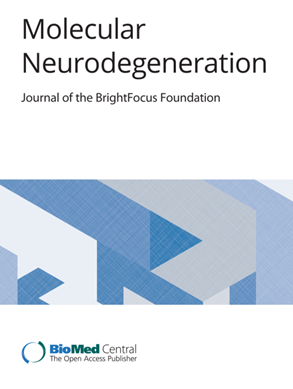Extracellular vesicles in TDP-43 proteinopathies: pathogenesis and biomarker potential
IF 17.5
1区 医学
Q1 NEUROSCIENCES
引用次数: 0
Abstract
Extracellular vesicles (EVs) are membrane-enclosed nanoparticles released by most cell types, and from multiple sub-cellular compartments. They carry a range of cargo biomolecules, including protein and RNA that reflect the type and status of their cell of origin. EVs are associated with the 43 kDa trans-active response DNA binding protein (TDP-43), aggregates of which are a key pathological feature across the spectrum of amyotrophic lateral sclerosis (ALS), frontotemporal dementia (FTD), and other TDP-43 proteinopathies. The secretion of TDP-43 via EVs may have beneficial effects through the cellular clearance of aggregated protein, or detrimental effects via the intercellular spread of templated TDP-43 aggregation. This review examines evidence for the association of TDP-43 with EVs in post mortem tissue, in vitro models and human biofluids, and discusses evidence for EV TDP-43 involvement in pathogenesis via clearance or ‘seeding’ processes. We further discuss the potential for use of EVs in biomarker development, through analysis of TDP-43 or alternative protein and RNA cargoes.TDP-43蛋白病变中的细胞外囊泡:发病机制和生物标志物潜力
细胞外囊泡(EVs)是由大多数细胞类型和多个亚细胞区室释放的膜封闭纳米颗粒。它们携带一系列的货物生物分子,包括蛋白质和RNA,反映其起源细胞的类型和状态。EVs与43 kDa的反式反应DNA结合蛋白(TDP-43)相关,其聚集是肌萎缩性侧索硬化症(ALS)、额颞叶痴呆(FTD)和其他TDP-43蛋白病变的关键病理特征。通过ev分泌TDP-43可能通过细胞清除聚集蛋白产生有益影响,也可能通过模板TDP-43聚集的细胞间扩散产生有害影响。本综述研究了死后组织、体外模型和人类生物体液中TDP-43与EV相关的证据,并讨论了TDP-43通过清除或“种子”过程参与EV发病机制的证据。通过分析TDP-43或替代蛋白和RNA载体,我们进一步讨论了ev在生物标志物开发中的应用潜力。
本文章由计算机程序翻译,如有差异,请以英文原文为准。
求助全文
约1分钟内获得全文
求助全文
来源期刊

Molecular Neurodegeneration
医学-神经科学
CiteScore
23.00
自引率
4.60%
发文量
78
审稿时长
6-12 weeks
期刊介绍:
Molecular Neurodegeneration, an open-access, peer-reviewed journal, comprehensively covers neurodegeneration research at the molecular and cellular levels.
Neurodegenerative diseases, such as Alzheimer's, Parkinson's, Huntington's, and prion diseases, fall under its purview. These disorders, often linked to advanced aging and characterized by varying degrees of dementia, pose a significant public health concern with the growing aging population. Recent strides in understanding the molecular and cellular mechanisms of these neurodegenerative disorders offer valuable insights into their pathogenesis.
 求助内容:
求助内容: 应助结果提醒方式:
应助结果提醒方式:


